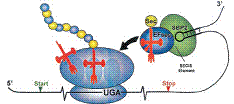Biochemistry, Department of

Vadim Gladyshev Publications
Document Type
Article
Date of this Version
November 2000
Abstract
Selenium has been implicated in cancer prevention, but the mechanism and possible involvement of selenoproteins in this process are not understood. To elucidate whether the 15-kDa selenoprotein may play a role in cancer etiology, the complete sequence of the human 15-kDa protein gene was determined, and various characteristics associated with expression of the protein were examined in normal and malignant cells and tissues. The 51-kilobase pair gene for the 15-kDa selenoprotein consisted of five exons and four introns and was localized on chromosome 1p31, a genetic locus commonly mutated or deleted in human cancers. Two stemloop structures resembling selenocysteine insertion sequence elements were identified in the 3’-untranslated region of the gene, and only one of these was functional. Two alleles in the human 15-kDa protein gene were identified that differed by two single nucleotide polymorphic sites that occurred within the selenocysteine insertion sequence-like structures. These 3’-untranslated region polymorphisms resulted in changes in selenocysteine incorporation into protein and responded differently to selenium supplementation. Human and mouse 15-kDa selenoprotein genes manifested the highest level of expression in prostate, liver, kidney, testis, and brain, and the level of the selenoprotein was reduced substantially in a malignant prostate cell line and in hepatocarcinoma. The expression pattern of the 15- kDa protein in normal and malignant tissues, the occurrence of polymorphisms associated with protein expression, the role of selenium in differential regulation of polymorphisms, and the chromosomal location of the gene may be relevant to a role of this protein in cancer.


Comments
THE JOURNAL OF BIOLOGICAL CHEMISTRY, Vol. 275, No. 45, Issue of November 10, pp. 35540–35547, 2000.